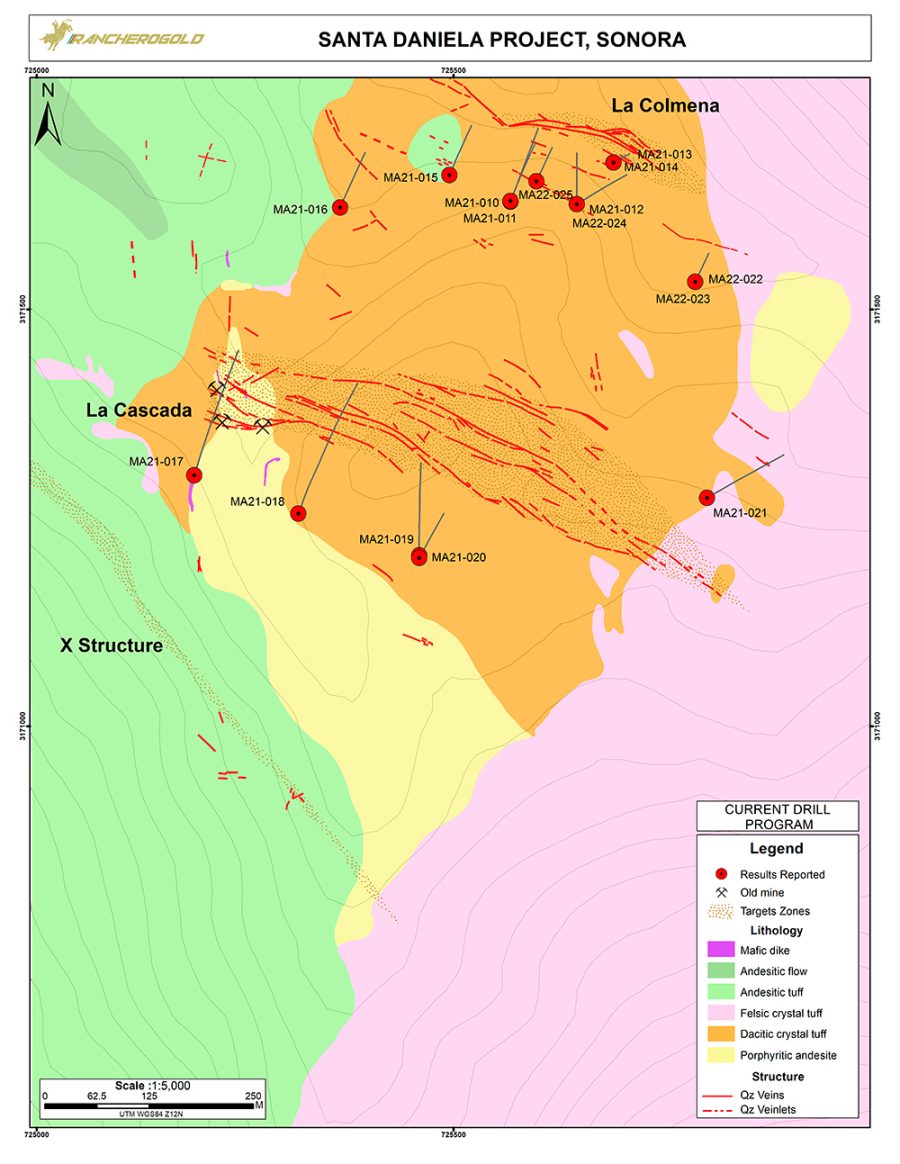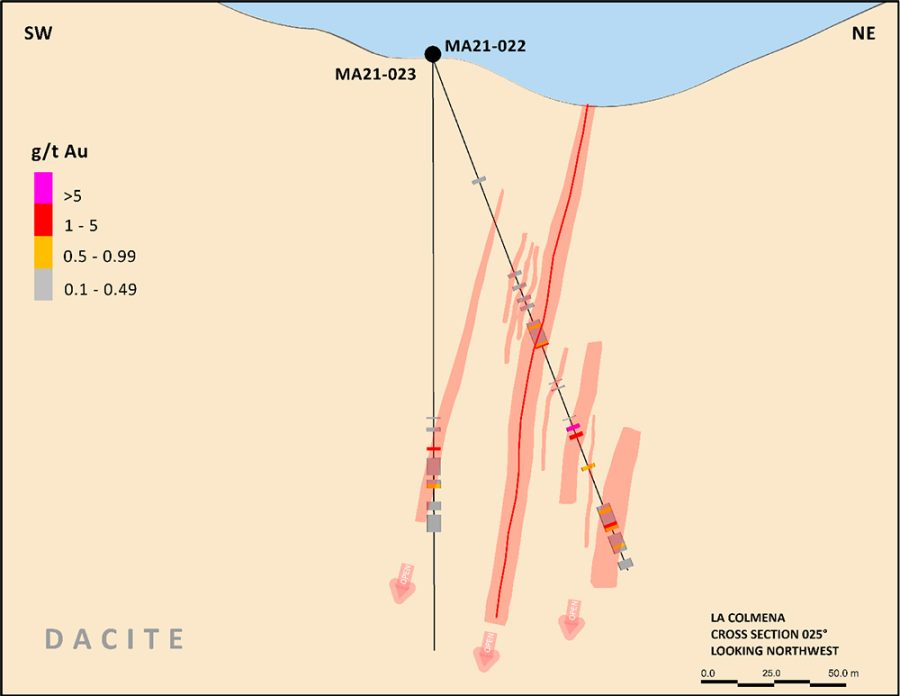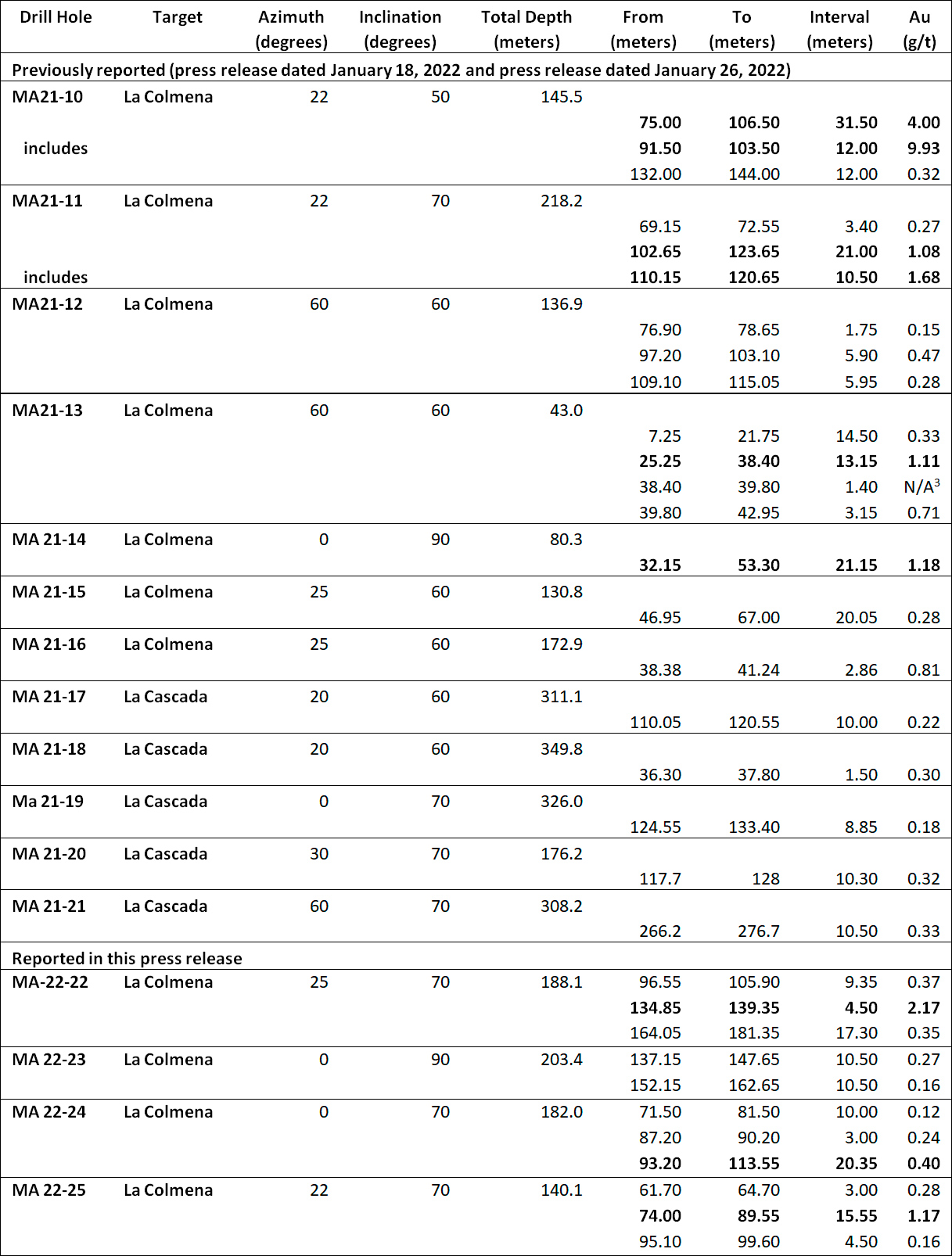ALL DRILL HOLES FROM PHASE I PROGRAM INTERSECTED GOLD MINERALIZATION
Vancouver, British Columbia, February 23, 2022– Ranchero Gold Corp. (“Ranchero” or the “Company”)(TSX.V:RNCH) is pleased to announce the final drill results from its recently completed Phase I drill program at the Maíz Azul prospect which is part of its 100%-owned Santa Daniela gold project located in Sonora, Mexico.
Highlights of the Drill Results:
• Ranchero has completed its Phase I drill program with total diamond core drilling of 3,112 meters exceeding the Company’s original planned drilling due to continued exploration success at the Maíz Azul prospect.
• All 16 completed drill holes have intersected gold mineralization.
• Additional drilling at the La Colmena target intersected 1.2g/t gold over 15.6 meters (MA 22-25) along strike from 4.0 g/t gold over 31.5 meters (MA 21-10) which was previously reported (press release January 18, 2022).
• Drilling designed to test the eastward extension of La Colmena successfully extended near surface gold mineralization over 260 meters along strike where it remains open.
• The Company will update its geologic mapping of Maíz Azul with the goal of using the volcanic-stratigraphic column to further identify new structures that control mineralization. This will greatly enhance the Company’s ability to develop new targets at and in close proximity to Maíz Azul.
• The Phase II drill program, planned for later this year, will focus on both expanding the newly discovered gold mineralization as well as testing additional targets including the X-Structure.
Maíz Azul is the Company’s most advanced prospect at the broader Santa Daniela gold project which consists of a land package in excess of 22,300hectares.
Bill Pincus, Chief Executive Officer of Ranchero stated: “We are extremely pleased with the results from our first ever drill program at Santa Daniela. We have demonstrated the presence of gold mineralization in all of the targets that were drill tested including intersecting 4.0 g/t gold over 31.5 meters in drill hole MA 21-10. The recent step-out hole (MA 22-22) demonstrated the presence of gold mineralization for over 260 meters where it remains open eastward at the La Colmena zone.
“We will now take a pause in drilling to update our geologic mapping and three-dimensional models. Continued exploration efforts at Maíz Azul has led to a greater understanding of the stratigraphic column which in turn has led to a better understanding of the major faulting that controls the gold deposition. This will guide our future drilling at Maíz Azul as well as our on-going reconnaissance work in the greater project area at Santa Daniela.”
PHASE I DRILL PROGRAM
The Phase I drill program was designed to test two principal targets at Maíz Azul: La Colmena and La Cascada (Figure 1). Drilling at La Colmena intersected gold in both high-grade hydrothermal breccia zones and lower-grade veinlet zones. Step-out drill hole MA-22-22 extended the La Colmena zone eastward a further 170 meters (Figure 2). There was minimal surface geochemical signature and this hole was based on structural trends visible on satellite images. This confirms the importance of structural interpretation in the discovery of new gold mineralization. Drilling at La Cascada generally encountered broader lower grade veinlet-hosted mineralization with only occasional hydrothermal breccias. Ranchero geologists note that this is, according to published reports, similar to the occurrence of gold mineralization at nearby mines which are and have been successfully mined by both open pit and underground methods.
It is also evident from the recent work that the Maíz Azul area has been heavily influenced by both high-angle and low-angle faulting. In some cases, displacement may be as much as 100 to 200 meters. This is evidenced by the missing layers of the volcanic-stratigraphic section identified by field observations and core logging. The discovery of widespread gold mineralization at Maíz Azul together with a greater understanding of the regional and local geology provides confirmation that the Phase I drill program was highly successful.
Ranchero also reports that further sampling of drill holes MA 21-13 and MA 21-14 (as discussed in the press release dated January 26, 2022) has resulted in a slight expansion of a mineralized intercept of MA 21-13. Complete assay results are reported in Table 1.
FUTURE WORK AND REGIONAL EXPLORATION
Ranchero geologists are currently engaged on several fronts at both Maíz Azul and on the reconnaissance of the greater Santa Daniela concession block.
The primary focus at Maíz Azul is on updating and expanding the mapped area. This will provide an enhanced understanding of the structural (fault) controls on the gold mineralization and will be an essential guide for the design of the upcoming Phase II drill program.
Reconnaissance efforts will be focused on those areas close to Maíz Azul that have been identified by remote sensing or other methods. Ranchero, working with GoldSpot Discoveries, is acquiring WaveView 3 satellite data to better identify new potential prospects.
Several areas have already been investigated via field visits. The completed field work in conjunction with newly identified areas, will be prioritized for follow-up sampling, mapping and possibly geophysical surveys. The identification of new drill targets will continue throughout the course of 2022 and beyond.
Figure 1: Drill Hole Location Map at Maíz Azul
Figure2: Cross Section for Drill Holes MA21-22 and MA21-23 – La Colmena Extension
Table 1: Drill Hole Interval
Notes:
1. Intersections presented herein may not necessarily represent true width of mineralization. Reported drill intercepts were based on a minimum grade of 0.1 ppm Au over 1.5 meters. Intervals are weight-average by sample length. Assay values are uncut. Intervals less than 3 meters are not included.
2. Ranchero has a Quality Assurance and Quality Control (“QA/QC”) program that conforms to industry best practices. Samples are delivered to ALS Global Labs in Hermosillo, Sonora, Mexico for preparation and analysis. The analytical method for gold is a 30-gram fire assay with atomic adsorption finish. Samples over 10 ppm are re-assayed by fire assay with a gravimetric finish. Strict sampling and QA/QC protocol are followed, including the insertion of standards, blanks, and duplicates on a routine basis. Results of these QC samples are tracked and failures are re-analyzed. Sample intervals are usually 1.5m but may be less. All exploration diamond drill cores are split in half by core sawing and sampled at appropriate intervals for assay. The remaining core, coarse reject and pulps are stored on-site in a secure location.
3. Drill Hole MA 21-13 encountered a 1.4-meternatural void in the rock during drilling. This occurred within a mineralized interval from 25.25 meters to 42.95 meters. For purposes of proper representation, the interval has been divided into two segments– one above and one below the void.
QUALIFIED PERSON
Scientific and technical information in this news release has been reviewed and approved by William Pincus, CPG, who is a “qualified person” as defined by NI 43-101.
ABOUT RANCHERO GOLD
Ranchero is a gold exploration and development company currently focused on its 100%-owned Santa Daniela project located in Sonora, Mexico. The Santa Daniela project consists of a large land package in excess of 22,300 hectares within Mexico’s Sierra Madre Occidental – a newly emerging goldbelt. The Santa Daniela project is also near a number of major gold mining operations in the region. Maíz Azul is the Company’s most advanced prospect where exploration efforts are underway.
On behalf of the Board of Directors of the Company:
William Pincus
Chief Executive Officer and Director
FOR FURTHER INFORMATION PLEASE CONTACT
William Pincus
Chief Executive Officer and Director
+1 303 589 3734
info@rancherogold.com
CAUTIONARY NOTE REGARDING FORWARD LOOKING STATEMENTS
This news release contains certain forward-looking statements. Any statements that express or involve discussions with respect to predictions, expectations, beliefs, plans, projections, objectives, assumptions or future events or performance (often, but not always, using words or phrases such as “expects” or “does not expect”, “is expected”, “anticipates” or “does not anticipate” “plans”, “estimates” or “intends” or stating that certain actions, events or results “ may”, “could”, “would”, “might” or “will” be taken, occur or be achieved) are not statements of historical fact and may be “forward-looking statements”. Forward-looking statements contained in this news release include, but are not limited to, the final acceptance of the TSXV to the Transaction.
Forward-looking statements are subject to a variety of risks and uncertainties which could cause actual events or results to materially differ from those reflected in the forward-looking statements. These risks and uncertainties include but are not limited to: risks related to regulatory approval, including the approval of the TSXV. There can be no assurance that forward-looking statement will prove to be accurate, and actual results and future events could differ materially from those anticipate in such statements. The Company undertakes no obligation to update forward-looking statements if circumstances or management’s estimates or opinions should change except as required by applicable securities laws. The reader is cautioned not to place undue reliance on forward-looking statements.




